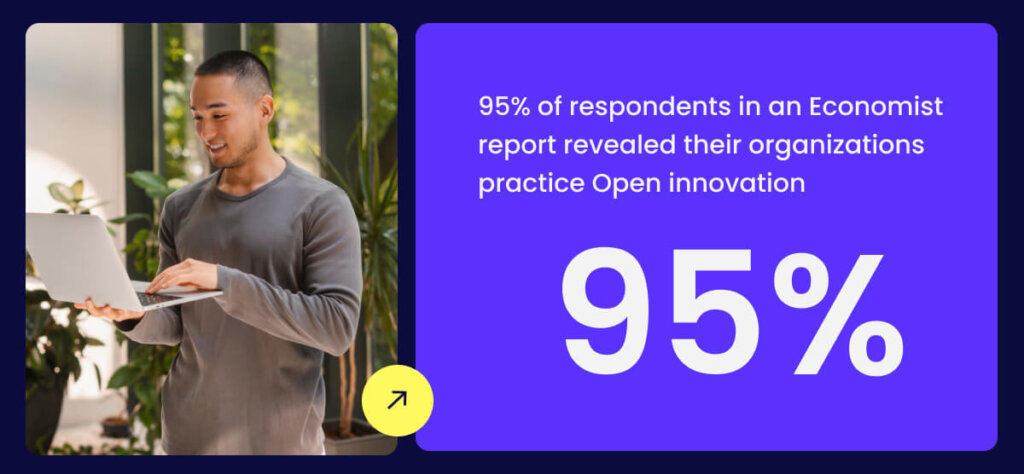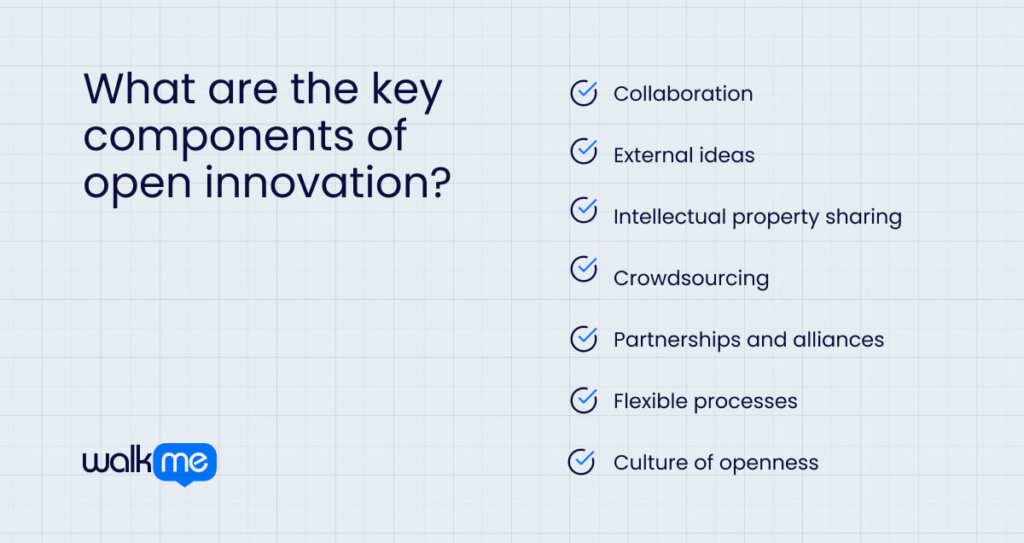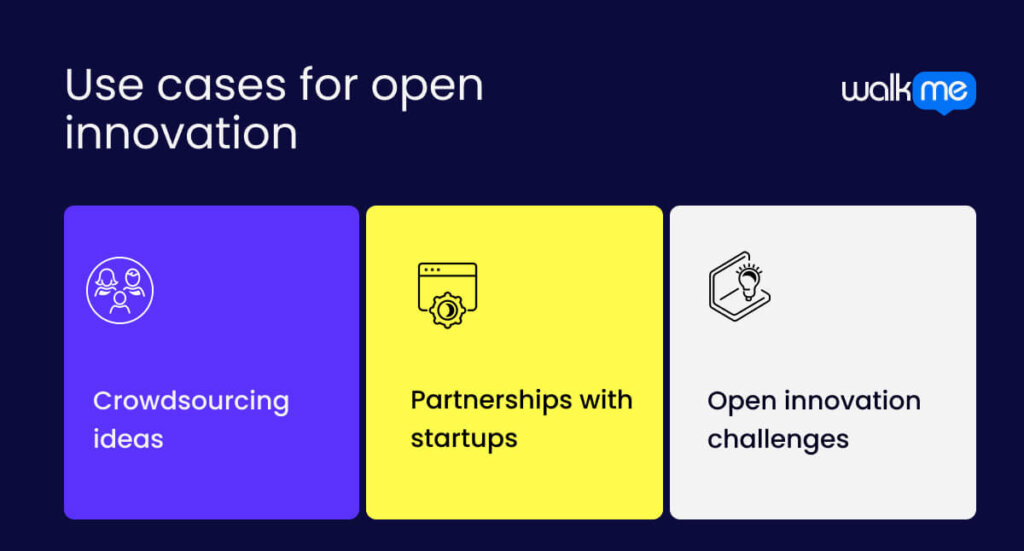Table of Content
Using open innovation helps companies stay strong in a fast-changing world. It means sharing ideas and working together to create new things. Development becomes quicker and cheaper because businesses can use what already exists instead of starting from scratch.
Open innovation is hugely popular. 95% of respondents in an Economist report revealed their organizations practice OI.

The practice changes how people in a company think, encourages teamwork, values outside ideas, and makes problem-solving easier. Using such an approach, businesses can create better products and build stronger connections with their partners, leading to lasting success.
What are the key components of open innovation?

Understanding the key parts of open innovation is important for understanding how it helps organizations collaborate and be creative. These parts work together to create an environment where outside ideas and resources mix with internal efforts. This improves problem-solving and speeds up the creation of new products and services.
Let’s look at the components that make open innovation effective and valuable.
Collaboration
Working with outside partners, like small businesses and schools, to share ideas. Helping teamwork to happen means companies can bring in different skills, leading to creative solutions. Good relationships with partners help make future projects more accessible.
External ideas
I find and use ideas from outside the company instead of relying only on internal teams. Looking outside helps businesses discover new ways to solve problems. They can more easily keep up with trends and serve their customers better.
Intellectual property sharing
Allowing different organizations to share and use each other’s ideas to encourage new developments. A system like this can lead to new products that help everyone—clear agreements on who owns what is important to protect interests.
Crowdsourcing
Asking the public for ideas and feedback on products can generate many creative ideas, helping to build a community around the brand. Involving customers can lead to products that really fit their needs.
Partnerships and alliances
Forming partnerships with other companies to combine strengths. These partnerships can share risks and costs, making it easier to create new things. Working together often leads to better solutions.
Flexible processes
Using methods that can easily change when new ideas come up. Flexibility helps companies respond quickly to market changes or customer needs. They can then enjoy ongoing improvement and faster innovation.
Culture of openness
Creating a company culture that values teamwork and outside ideas. An open culture encourages employees to share their thoughts and connect with others. Companies with such a setup often have happier employees and a more innovative workplace.
Open innovation vs closed innovation
Open innovation and closed innovation are two different ways to create new products.
- Open innovation uses ideas and helps from outside the company, encouraging teamwork with partners and customers.
- Closed innovation depends only on the company’s own resources, where teams work on products without outside help.
Let’s look at the key differences between these two terms.
| Open innovation | Closed innovation | |
| Definition | Companies use ideas and help from outside to create new products. They work with partners like startups, schools, and customers. | Companies only use their own ideas and resources. They make new products with their own teams, keeping everything inside. |
| Focus | Teamwork and sharing. Companies mix ideas and skills from outside to help create new things. | Internal work. Companies concentrate on their own research and protect their ideas from others. |
| Techniques | Asking the public for ideas, forming partnerships, sharing information, and getting feedback from others. | Traditional research, brainstorming in-house, and controlling the process without outside help. |
| Goals | Increase creativity, speed up product development, and improve products by using outside knowledge. | Keep control of the innovation process and protect ideas, so all new products come from within the company. |
| Examples of use | Companies like LEGO and Procter & Gamble use open innovation by involving customers and partners to create new ideas. | Companies like Apple often use closed innovation, focusing on their own teams to develop products like the iPhone without outside help. |
Use cases for open innovation

Open innovation is used in many business situations. It helps companies gather new ideas, team up with startups, or hold contests to find creative solutions. These methods boost creativity and speed up the creation of new products.
To explain how open innovation works, here are three examples that show it in action.
Crowdsourcing ideas
Crowdsourcing lets companies gather ideas from the public or specific groups. For example, a food company might ask customers to suggest new snack flavors.
The company collects these ideas through social media or contests. They can find unique flavors that people really want. By involving the public, they save time on brainstorming and create products that are more likely to be popular.
Partnerships with startups
Large companies can team up with startups to share knowledge and resources. For instance, a big tech company might work with a small startup that has cool new software.
Such a partnership helps the large company access fresh ideas and new technology. It also gives the startup a chance to grow and get noticed. Together, they can create great products faster than either could alone.
This setup happens often – a recent OI report reveals that 69% of corporates had plans to collaborate with startups in the next 18 months.
Open innovation challenges
Companies can hold challenges where people compete to solve a specific problem. For example, a car maker might ask inventors to design a new fuel-efficient engine.
Participants send in their designs, and the best ones can win prizes or contracts. Using this approach encourages creativity and brings in many ideas that the company might not have thought of. It helps speed up innovation while connecting with the community.
What are the advantages of open innovation?
Open innovation gives many benefits to businesses. By using ideas and help from outside, companies can be more creative and make products faster. The way of working also helps save money, reach more customers, and build better relationships. Let’s look at the main advantages of open innovation.
Boosts creativity
Open innovation brings in new ideas from outside the company. It helps spark fresh thinking and leads to creative solutions. Businesses can find unique products they might not have otherwise considered by involving different people. Working with various minds encourages trying new things that can create exciting innovations.
Speeds up development
Working with outside partners helps companies make products faster. They share resources and skills, which makes things quicker. New products can reach stores sooner, allowing the company stay competitive. Faster development also helps companies respond quickly to what customers want.
Reduces costs
Open innovation can lower costs by using outside ideas. Instead of spending a lot on their own research, companies can use what others already know. The approach saves money while still allowing for new ideas. Getting outside support can help companies avoid expensive mistakes and work better.
Expands market reach
Partnering with others helps companies meet new customers. By working with customers and outside partners, businesses can understand what people want. They can then create products that are more popular. Reaching more customers opens up chances for sales and growth.
Enhances problem-solving
Open innovation encourages teamwork with different groups, leading to better solutions for hard problems. Different views help teams think creatively, tackle challenges, and find good answers. Bringing together different skills can speed up problem-solving and lead to stronger results.
Increases flexibility
Using open innovation helps companies change quickly when needed. They can look for new ideas from outside. Remaining flexible helps businesses stay relevant and meet customer needs. Being able to change direction also lowers the risk of falling behind.
Builds stronger relationships
Working with outside partners and customers builds better connections. These relationships create trust and loyalty, helping both the company and its partners. Stronger ties can lead to future chances to work together. Focusing on these relationships helps create a community that supports growth.
Fosters a culture of innovation
Open innovation encourages teamwork and creativity in the company. When employees see the value of working together, they share more ideas. Creating such a culture can lead to improvement and success. Encouraging everyone to think creatively helps the company do well.
What are the challenges of open innovation?
Businesses want to be more creative and develop products faster by using ideas and help from outside the company. However, this method has its own set of problems that need to be handled. Knowing these challenges is important for making open innovation work well.
Intellectual property risks
When using open innovation, companies may worry about protecting their ideas. Sharing information with outside partners can lead to risks of ideas being copied or misused. Confusion can arise about who owns what, which may lead to legal problems. Companies must take extra steps to keep their ideas safe, which can add to their workload.
Communication barriers
Working with outside partners can create communication problems. Different teams may have different ways of working and talking. Misunderstandings may happen and slow progress if everyone is not on the same page. Regular meetings and clear rules can help, but they also take time and effort.
Quality control
With open innovation, companies depend on ideas from many sources. Sometimes this can lead to quality issues. Not all outside ideas may meet the company’s standards, which can cause problems in the final product. Companies need to set clear rules for checking outside ideas to ensure quality.
Integration difficulties
Bringing in outside ideas can be hard to fit into the company’s current processes. Companies may struggle to blend new ideas with their existing systems and culture. Finding ways to match new ideas with current practices is important for success.
How can DAPs help with open innovation?
Digital adoption platforms (DAPs) are important for improving open innovation. When businesses use a DAP, they can facilitate teamwork and idea-sharing among their teams and partners. The platform provides tools that help companies organize their work and find useful information, simplifying innovation.
Let’s look at how DAPs support open innovation and encourage creativity in different business settings.
Collaboration tools
Collaboration tools are available to help teams work together better. These tools let people from different backgrounds share ideas and resources easily. They also provide spaces for discussions and feedback, making it simpler for everyone to contribute and stay connected. By improving communication, DAPs reduce misunderstandings and keep projects on track. A friendly environment is created where everyone’s ideas can be heard.
Knowledge sharing
The platforms help with knowledge sharing by making important information easy for all team members to find. They can store documents, reports, and best practices in one place. As a result, everyone has the information they need to make good decisions and be creative. Easy access to knowledge helps teamwork and reduces repeated work. It also makes sure important ideas are noticed.
Easy onboarding
DAPs make onboarding new partners and team members easier. They provide step-by-step guides and resources to help newcomers learn quickly. A setup like this reduces the time needed for training and lets new people help with open innovation sooner. A smooth employee onboarding process builds confidence and encourages participation. It also helps everyone work better together by including new members effectively.
Performance tracking
With this software, companies can track the progress of open innovation projects. They provide tools to check progress, gather feedback, and measure results. This helps teams see what is working well and what needs fixing, keeping innovation efforts on track. Regular tracking allows for quick changes to plans, improving results. It also encourages accountability, as teams can see how their work affects the project.

